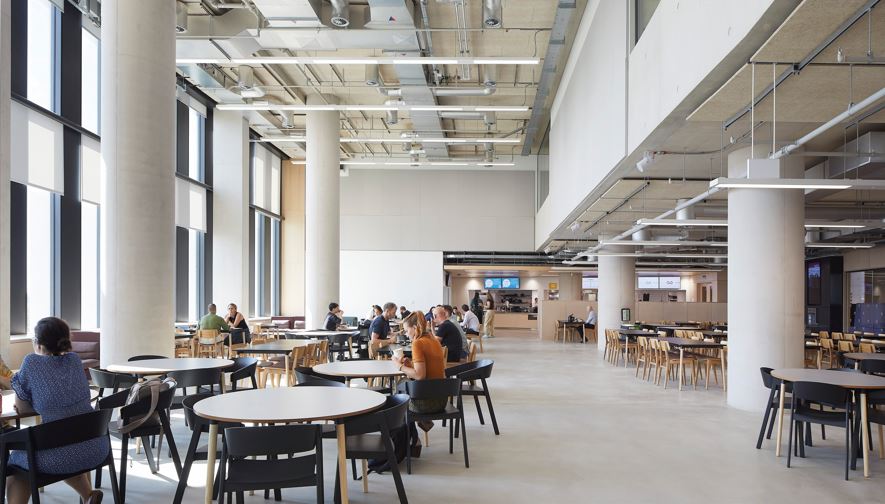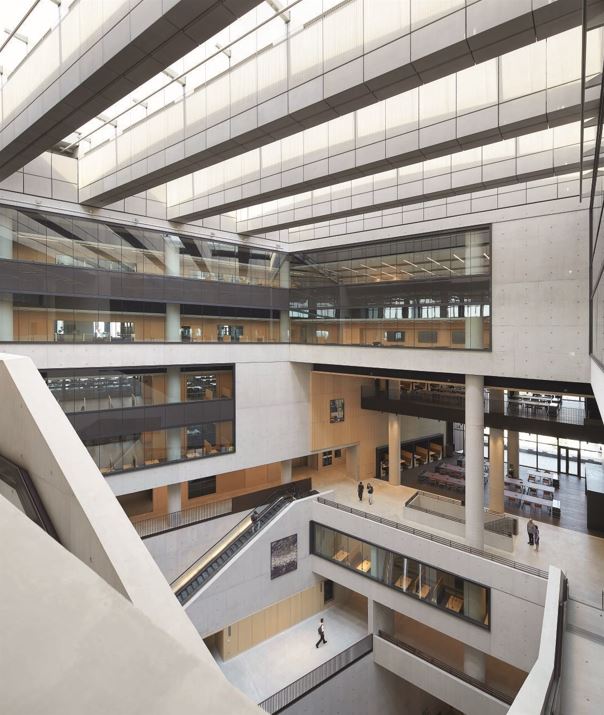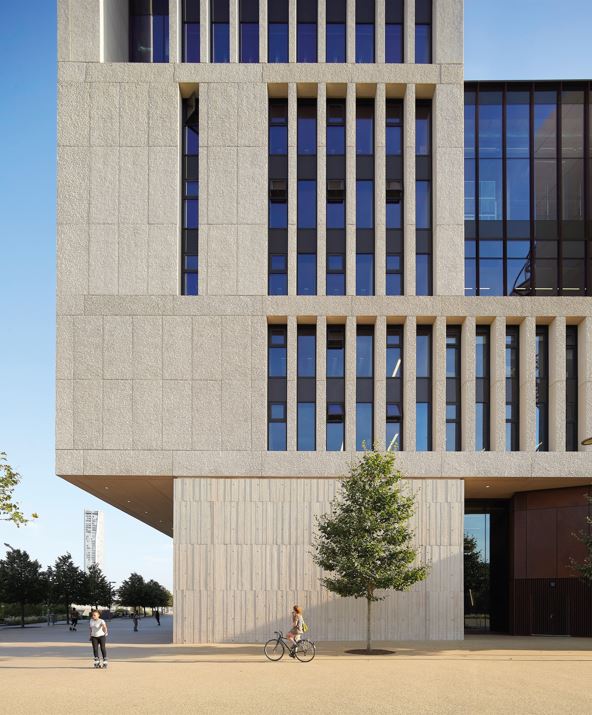
Marshgate, a 35,000sqm state-of-the-art academic building designed by Stanton Williams, has completed at the forefront of the UCL East campus, in London’s Queen Elizabeth Olympic Park.
Marshgate is designed to create a collaborative and cross-disciplinary educational environment focused on finding solutions to today’s biggest social, environmental and technological challenges, drawing on the shared knowledge and expertise of the many faculties that will converge at the new east London campus. The landmark scheme, UCL’s largest single building, offers eight floors of open and adaptable teaching, research and collaboration spaces, for fields ranging from the creative industries to engineering, robotics, green technologies and global health - inviting new and interconnected modes of working, and entirely new research avenues and disciplines to emerge. Setting the standard for a new type of university campus, the building is designed to break down siloes and promote and cross-disciplinary learning, thinking and research, bringing together students, academics, and the public. Different floors are clustered into a series of ‘neighbourhoods’, each with its own double-height collaboration space for informal meetings or exhibitions. The lower levels of the building include a network of publicly accessible spaces, with a café, public art displays and activities designed to draw schools, community organisations and the public into the life and heart of the building. Newly landscaped public realm provides an animated and accessible interface with both the adjacent riverside and wider Queen Elizabeth Olympic Park.
While public amenities predominantly populate the ground level, student, academic and research spaces are concentrated on the central floors, and highly specialised laboratories and workshops are primarily situated on the building’s upper levels. This configuration emerged from end-user briefing carried out by Stanton Williams to the end of RIBA Stage 3, with further end-user briefing sessions carried out by joint interior architect Sheppard Robson in the subsequent stages. Sheppard Robson built on Stanton Williams’ design to configure internal spaces to meet the University’s requirements, including lending specialist experience in designing laboratories, workshops and a range of workspaces. A central, day-lit atrium vertically connects all the building’s activities, and highly visible circulation routes including stairs and escalators create further opportunities for chance encounters and interaction. Additional facilities include fabrication workshops, media studios, exhibition areas, design studios, lecture theatres, a library and an executive suite and spaces for collaboration and engagement with local businesses and communities. In a departure from the trend towards glassy, light-weight curtain wall facades, Marshgate is built to echo the solidity and permanence of UCL’s original Bloomsbury campus.
The massing also speaks to the site’s industrial past, referencing the buildings that historically populated the surrounding Lea Valley, while responding to the bold sculptural forms of the contemporary neighbouring Olympic structures. Comprised of in-situ and precast concrete panels in subtly graded tones and textures, the façade features timber board marked concrete on the lower floors and upper levels sculpted to optimise natural daylight and ventilation. Reflecting UCL’s overarching mission to embed sustainability through its campus and culture, durability and energy efficiency were at the front of Stanton Williams’ design approach. The BREEAM Excellent-rated building marries a strong and enduring identity with a highly flexible and long-life design approach to space and programming, and the solidity of the facade delivers high thermal performance and solar shading. Passive design strategies informed the overall building design, and the all-electric building is powered in part by renewable electricity, with the aim to reach net zero carbon by 2035 in keeping with the district’s wider sustainable energy strategy. Together with the recently completed One Pool Street building, designed by Lifschutz Davidson Sandilands, which comprises both academic spaces and student accommodation, Marshgate marks the completion of the first phase of the UCL East campus masterplan, UCL’s biggest expansion in its 200-year history.

It also marks a major milestone in the wider creation of East Bank, a new cultural quarter for innovation, creativity and learning supported by the Mayor of London, which will include UAL’s London College of Fashion, a new Sadler’s Wells East theatre and new bases for BBC Music and V&A East. Marshgate is also situated within Stratford’s SHIFT innovation district, a highly collaborative initiative headed up by UCL and other major bodies to bring together the public and private sectors with education, local communities, innovative enterprises, and tech companies to find, test and demonstrate interventions to make cities safer, healthier and more sustainable. Gavin Henderson, Principal Director, Stanton Williams, said: “Drawing on the legacy of Lee Valley's industriousness and creativity, and the exceptional cultural and landscape setting of the Queen Elizabeth Olympic Park, Marshgate will be a place of curiosity, learning and collaboration. A place that engages with the surrounding city to create a new kind of university experience that balances a sense of permanence with a designed in flexibility that will both facilitate and embrace the rapidly evolving nature of academic practice.” Professor Paola Lettieri, Pro-Provost UCL East, commented: “The issues facing people and the planet have never been more complex or more urgent.
I am confident that the increased scale and space that our UCL East campus will give us, where departments and faculties are all coming together to problem-solve under the same roof, will accelerate the breakthroughs and disruptive discoveries that UCL is known for around the world. Marshgate, with its magnificent design and extraordinary facilities, will be home to research collaborations and world-leading programmes of study, that I am confident will impact both locally and globally." Terry Spraggett, MD Public Sector Construction, Mace said: “It has been fantastic to work with UCL, the wider project team and our supply chain partners on such an outstanding building. Marshgate is exceptional in its vision – championing collaboration not just between the students and academics but including the wider public. Working closely with the community has been a core component of the delivery strategy to ensure we create long-term social value for the wider campus. I can’t wait to see Marshgate open and all the great ideas and innovations come to life.” At capacity, UCL East’s new campus will comprise a community of around 4,000 students and 700 staff and offer a range of year-round activities and engagement opportunities for the public.


